Night Photography
by Michael Frye | Oct 20, 2024 | Night Photography, Travels and Stories
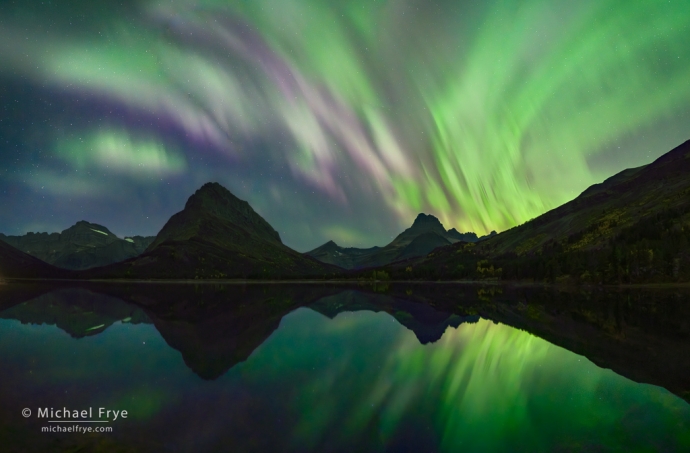
Aurora reflected in Swiftcurrent Lake, Glacier NP, Montana. The aurora was dancing and shimmering at an incredible rate of speed when I made this photo. This is a stitched panorama; four frames, with the camera and 20mm lens turned vertically, blended with Lightroom’s Panorama Merge, and then run through Lightroom’s Denoise. I wasn’t sure if stitched panoramas would work with the aurora moving so quickly, but luckily they did (most of the time). Each frame was 1 second at f/1.8, ISO 6400.
In late September Claudia and I made our annual pilgrimage to the Millpond Music Festival in Bishop, California. Then we drove to Kanab, Utah, for the Nightscaper conference – which turned out to be a super fun event. Kudos to the National Parks at Night team (Lance Keimig, Chris Nicholson, Tim Cooper, Gabriel Biderman, and Matt Hill) for making everything run so smoothly!
After the conference, we planned to just go wherever things looked interesting. We decided to head to southwest Colorado to look for fall color. But as soon as we arrived I started getting alerts about increased solar activity, and the possibility of seeing auroras at mid latitudes.
(more…)
by Michael Frye | Sep 1, 2024 | Night Photography
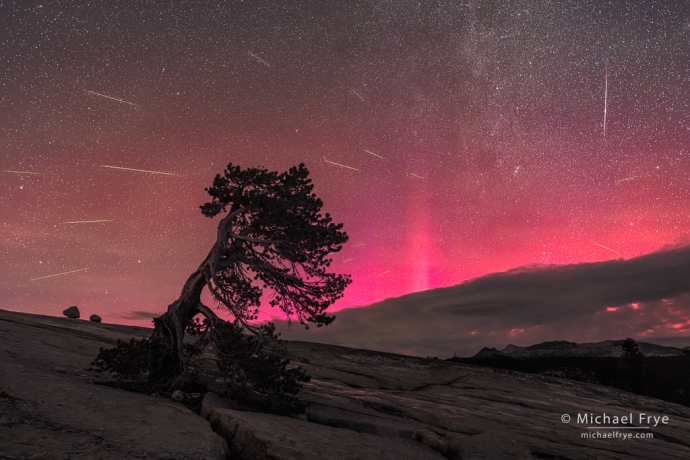
Aurora, Perseid meteors, and lodgepole pine, August 11-12, Yosemite NP, California. This image shows the Aurora Borealis, plus Perseid meteors captured over the course of about two hours.
The night of August 11th was the peak of the Perseid meteor shower. Claudia and I marked this date on our mental calendars, thinking it might be nice to head up to the Yosemite high country and look at some meteors.
As the date approached, solar activity increased, bringing a heightened chance of viewing the aurora – possibly even at our southerly location in central California. The combination of meteors and aurora certainly seemed intriguing. And forecasts indicated that the night of the 11th and 12th was the most likely night to see the aurora.
(more…)
by Michael Frye | Aug 29, 2024 | Announcements, Night Photography
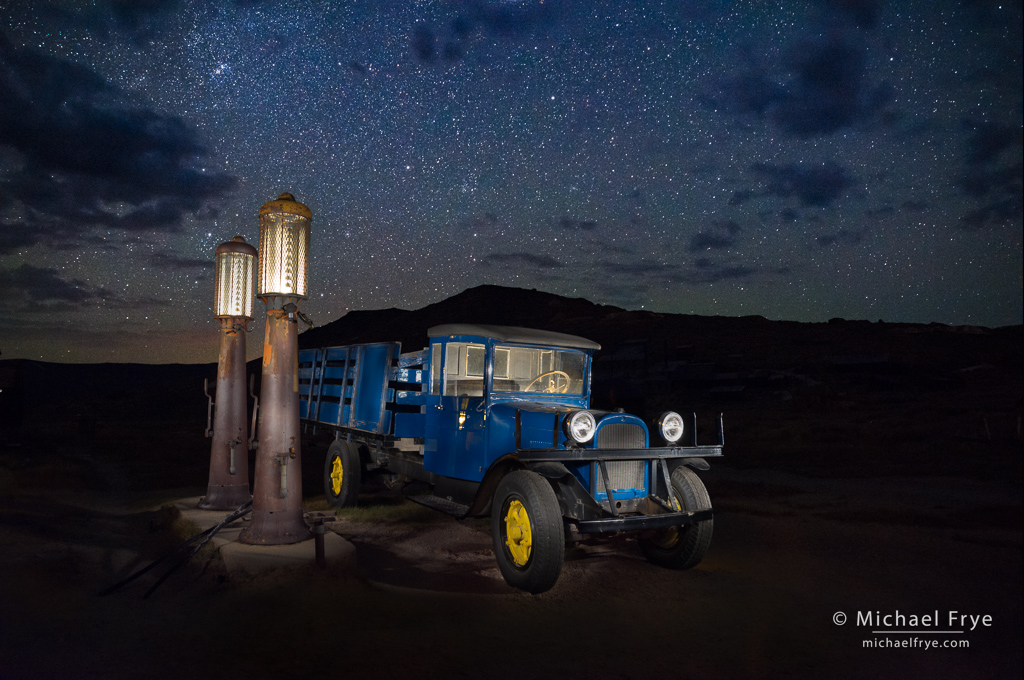
1927 Dodge Graham with gas pumps at night, Bodie State Historic Park, California. In my presentation Complex Lighting With One Flashlight I’ll show how to create rich, complex, sophisticated lighting with just one flashlight – as I did in this photo, lighting the old truck and gas pumps from multiple angles with just one light.
August 31st is the last day to get the early-bird discount on the Nightscaper Photo Conference!
This conference, focused on night photography, takes place September 26-29 in Kanab, Utah. I’ll be making two presentations at this event: Complex Lighting With One Flashlight, and Nighttime Sequences. And I’ll be teaching alongside a stellar lineup of other presenters, including Lance Keimig, Royce Bair, Jess Santos, Matt Hill, Tim Cooper, Rafael Pons, Katrina Brown, and a bunch more. Topics include star trails, auroras, printing, panoramas, deep-space astrophotography, Photoshop selections and masks, planning with PhotoPills – too many more to list them all here, but you can see all the details on the Nightscaper website:
(more…)
by Michael Frye | Jan 28, 2024 | Announcements, Night Photography
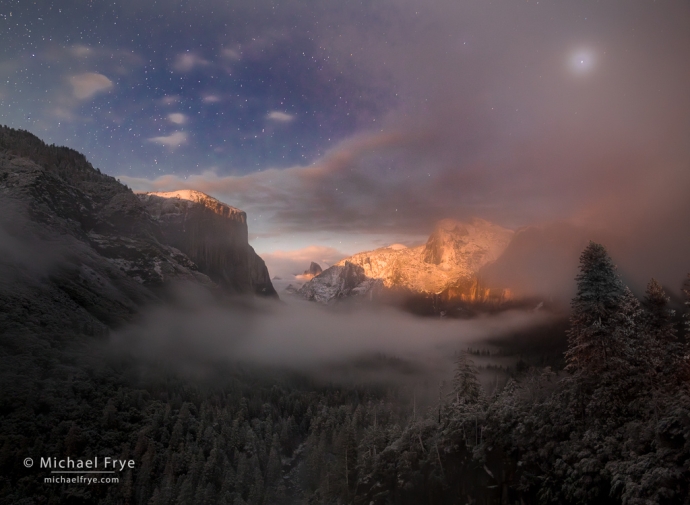
Yosemite Valley lit by the setting moon, with Jupiter above, Yosemite NP, California
I’ve been working on my presentation The Magic of Moonlight for the Night Photo Summit next weekend. While going through some of my moonlit images from the past I found this set, all from the night of December 19th and 20th, 2015.
Thinking about that night brings back some great memories. A winter storm started clearing around 9:00 p.m., so I headed up to Yosemite Valley, knowing that the two-thirds full moon was due to set at 1:45 a.m., and as it sank I might find some beautiful, low-angle moonlight to go along with that clearing storm.
(more…)
by Michael Frye | Mar 18, 2023 | Night Photography
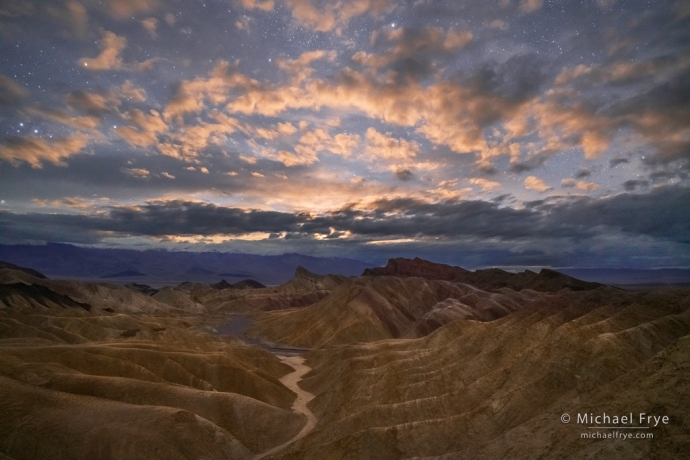
Clouds lit by the setting moon, Death Valley NP, California
The night after the rainstorm cleared during our recent visit to Death Valley, the half-full moon was due to set around midnight, and I thought there might be an opportunity to photograph an interesting moonset if the clouds lingered.
Claudia and I ate dinner at our campsite, slept for about an hour, then I got up and checked the weather. Things looked promising, with clouds, but not too many. So we headed to a spot looking over the badlands toward the lowering moon.
(more…)
by Michael Frye | Sep 7, 2022 | Night Photography, Travels and Stories
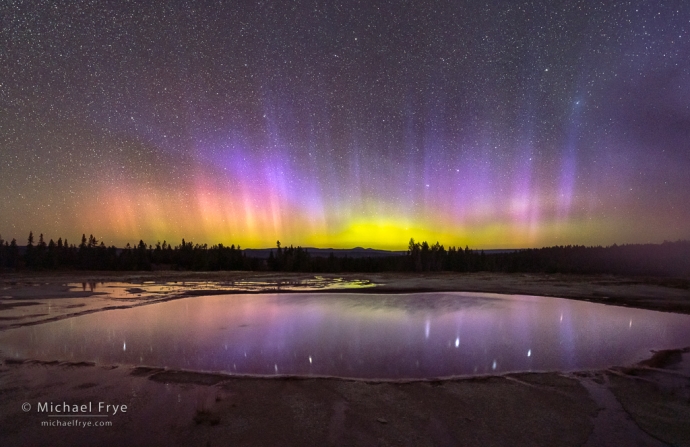
Aurora borealis reflected in a thermal pool, Yellowstone NP, Wyoming. 20mm, 10 seconds at f/1.8, ISO 6400. I would typically use a little longer shutter speed for night photos like this, but the aurora was moving and changing quite quickly, so a longer exposure would have caused the pillars to blur and smear together.
Claudia and I are back in Yellowstone. We had such a great time here last year we had to return.
And we’re glad we did. We’ve experienced many memorable moments so far, but the clear highlight was seeing and photographing the aurora borealis (aka Northern Lights) early Sunday morning.
We surely wouldn’t have done this if it weren’t for our friends David Kingham and Jennifer Renwick. Jennifer and David are both wonderful photographers, and know Yellowstone inside out. Before Claudia and I arrived in Yellowstone they saw and photographed an aurora one night. It wasn’t the most intense aurora, but it was something.
(more…)














